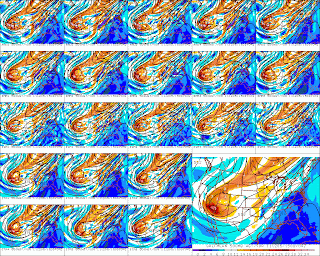 |
| Figure 4. Same as figure 3 except for the forecast made 02 December 2011 - 15 UTC. |
Needless to say, the impact of this bullish turn of model projections instigated a rush to the Hazardous Weather Testbed by all sorts of National Weather Center members (figure 5). That included me of course. We all wanted to see the monster snowstorm play out on the various model runs displayed on the big 60" monitors.
 |
| Figure 5. A scene from the Hazardous Weather Testbed from 02 December 2011. |
MEANWHILE...ANOTHER STORM SYSTEM OVER THE SOUTHWESTERN STATES WILL BEGIN TO MOVE EAST BY SUNDAY NIGHT. PRECIPITATION... MAINLY IN THE FORM OF SNOW...MAY BEGIN TO FALL ACROSS PARTS OF WESTERN OKLAHOMA AND WESTERN NORTH TEXAS AS EARLY AS SUNDAY NIGHT. ON MONDAY...SNOW MAY SPREAD EAST INTO CENTRAL AND SOUTHERN PARTS OF OKLAHOMA. AT THIS TIME...THE BEST OPPORTUNITY FOR ACCUMULATING SNOWFALL APPEARS TO BE SOUTH OF A LINE FROM TULSA TO OKLAHOMA CITY TO LAWTON AND VERNON...TEXAS. IT IS TOO EARLY TO PREDICT EXACT AMOUNTS OF SNOW AND THERE IS STILL THE POSSIBILITY THAT LITTLE OR NO SNOW WILL FALL.
The bullish snow forecasts continued for another two SREF ensemble runs and then the disappointment began. Starting with the 03 December 03 UTC run, most of the members of the ensemble started to back away from the prodigious snow totals. By the late morning on the 3rd, the runs showed almost nothing. The NWS office, acting with momentum, kept the wording in for potential snow, forecasting 3-6" in snow bands from their 5 am outlook, and then started to back off by 11 am with wording as below:
AT THIS TIME...THE BEST OPPORTUNITY FOR ACCUMULATING SNOWFALL APPEARS TO EXTEND FROM NEAR HOLLIS... VERNON AND WICHITA FALLS AREAS NORTHEAST TOWARD HOBART... LAWTON... DUNCAN...OKLAHOMA CITY...AND STILLWATER. WIDESPREAD LIGHT ACCUMULATIONS LESS THAN TWO INCHES ARE EXPECTED...AND THESE ACCUMULATIONS WOULD BE MAINLY CONFINED TO GRASSY SURFACES...CARS... AND TREES.
Well, the model runs kept going drier and drier to the point where nothing was forecast by 36 hours in advance of the supposed event. To see an animation of SREF dmodel/dt, check out the 500 mb (figure 6), surface 6 hour precipitation plots (figure 7) from the Penn State e-wall site. There's a few missing runs and panels but the point should be made pretty clear about the phantom snow runs starting early morning on the 2nd and then ending 24 hours later.
 |
| Figure 7. Similar to figure 6 except for sea-level pressure, 1000-500 mb thickness and 3 hour precipitation in mm. |
Perhaps this animation below better shows the onset and demise of our wishes for a big snow storm using dmodel/dt of our time trace SREF forecast snow accumulation courtesy of BUFKIT (figure 8). The white traces represent total snow accumulations by each run where time increases to the left. The animation starts out with only a couple members forecast a few inches by 15 UTC on 05 December (Monday), then a sudden surge in model aggressiveness with a few members going well above 8" and then the disappointing demise of the potential at the end of the loop (that's 15 UTC 03 December).
 |
| Figure 8. Similar to figure 3 except that this is a loop of meteograms starting from 01 December 2011 - 21 UTC and ending 03 December 2011 - 21 UTC. |
My takeaway from this event was that inter run differences can still exceed the range of possibilities within each ensemble run. I may be too harsh because technically there was an ensemble member during the most bullish SREF that had little snow but no runs during the Friday late morning runs were forecasting a totally dry Monday. Two runs later Friday night and we see a bunch of dry runs.
So, like the NWS, it's preferable to play the role of being a 'big ship' and contain our collective excitement. Luckily no watches or warnings were issued because the forecasters were not sold yet on an event that would overwhelm the relatively warm ground with loads of snow and ice. Still, it is okay to dream a little with some help from an overly aggressive model run. After all, sometimes we get an event that exceeds its expectations.




No comments:
Post a Comment